-
 Bitcoin
Bitcoin $106,437.2012
0.82% -
 Ethereum
Ethereum $2,442.5287
0.82% -
 Tether USDt
Tether USDt $1.0005
-0.02% -
 XRP
XRP $2.1812
-0.27% -
 BNB
BNB $645.1327
0.45% -
 Solana
Solana $146.2379
0.39% -
 USDC
USDC $0.9999
-0.01% -
 TRON
TRON $0.2751
0.92% -
 Dogecoin
Dogecoin $0.1662
-0.23% -
 Cardano
Cardano $0.5827
-1.22% -
 Hyperliquid
Hyperliquid $37.5225
0.04% -
 Bitcoin Cash
Bitcoin Cash $479.0877
4.02% -
 Sui
Sui $2.7846
-3.27% -
 Chainlink
Chainlink $13.3576
0.84% -
 UNUS SED LEO
UNUS SED LEO $9.0252
-1.20% -
 Stellar
Stellar $0.2455
-1.07% -
 Avalanche
Avalanche $18.0680
-1.81% -
 Toncoin
Toncoin $2.8948
-1.07% -
 Shiba Inu
Shiba Inu $0.0...01164
-1.65% -
 Litecoin
Litecoin $85.0637
-0.06% -
 Hedera
Hedera $0.1526
-0.89% -
 Monero
Monero $316.2941
0.78% -
 Ethena USDe
Ethena USDe $1.0003
-0.04% -
 Polkadot
Polkadot $3.4113
-1.87% -
 Dai
Dai $1.0000
-0.01% -
 Bitget Token
Bitget Token $4.4488
5.16% -
 Uniswap
Uniswap $7.1740
3.09% -
 Pi
Pi $0.5968
11.43% -
 Pepe
Pepe $0.0...01010
-0.65% -
 Aave
Aave $264.3189
0.40%
Is it normal to adjust with a shrinking volume for three consecutive days after breaking through the previous high with a large volume?
A breakout with high volume followed by three days of shrinking volume often signals healthy consolidation, not necessarily a reversal, especially if price holds above key support levels.
Jun 25, 2025 at 03:49 pm
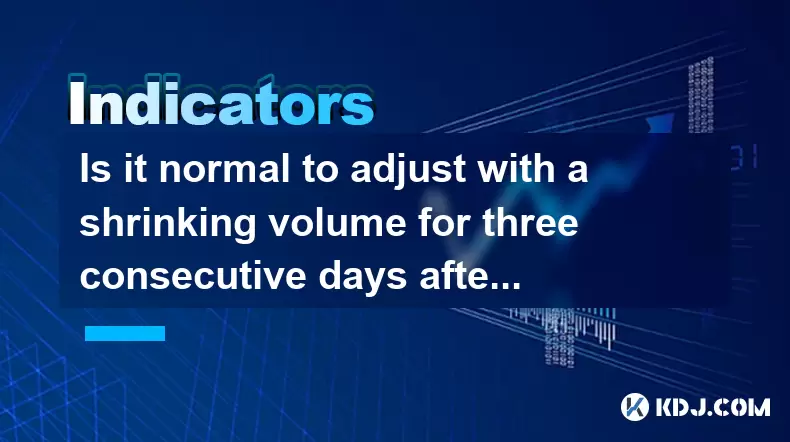
Understanding Volume and Price Relationship in Cryptocurrency Trading
In cryptocurrency markets, volume is a critical metric that reflects the number of assets traded over a specific period. When a cryptocurrency breaks through a previous high with large volume, it typically signals strong buying pressure and market confidence. However, it's not uncommon for the subsequent days to show shrinking trading volumes, even if the price continues to rise or consolidates.
The phenomenon of declining volume after a breakout can be attributed to several factors. One possible explanation is profit-taking. After a significant rally, early buyers may start selling their positions to lock in profits, leading to a temporary decrease in volume. Another reason could be market hesitation — traders might wait for clearer signals before entering new positions, especially if they're uncertain about the sustainability of the breakout.
Technical Interpretation of Shrinking Volume Post-Breakout
From a technical analysis perspective, a breakout accompanied by high volume is considered more valid than one with low volume. This is because high volume confirms the strength behind the move. However, what happens afterward is equally important.
When volume shrinks for three consecutive days after such a breakout, it doesn’t necessarily mean the trend is reversing. In fact, this kind of consolidation phase often precedes further upward movement. The key here is to assess whether the price remains above the breakout level and whether any pullbacks are shallow. If both conditions hold true, the shrinking volume may simply reflect a pause rather than a reversal.
It’s also crucial to analyze volume patterns across multiple timeframes. For instance, on daily charts, a drop in volume might seem concerning, but zooming into the 4-hour or 1-hour chart could reveal consistent accumulation by institutional players or whales, which isn't immediately visible on higher timeframes.
Historical Patterns in Crypto Markets
Looking at historical data from major cryptocurrencies like Bitcoin (BTC) and Ethereum (ETH), similar patterns have occurred during bullish phases. For example, during the late 2020 bull run, BTC experienced multiple breakouts followed by periods of declining volume. Despite the lower activity, prices continued to climb as long as support levels held and no bearish candlestick patterns emerged.
Another case was observed in mid-2021 when ETH broke out of its resistance zone with massive volume. Over the next few days, volume dropped significantly, yet the price maintained an upward trajectory. This illustrates how volume contraction after a breakout doesn’t always equate to weakness.
One should also consider market sentiment indicators like the Fear & Greed Index or social media engagement metrics. These tools help determine whether the decline in volume is due to complacency or strategic positioning by larger players who are quietly accumulating without triggering panic or euphoria.
How to Analyze Shrinking Volume: A Step-by-Step Guide
If you're observing a scenario where a cryptocurrency breaks out with high volume but then experiences three days of shrinking volume, follow these steps to conduct a deeper analysis:
- Confirm the Breakout: Ensure that the asset has indeed broken above a significant resistance level with substantial volume.
- Check Key Support Levels: Monitor whether the price stays above the breakout level or starts to retrace significantly.
- Analyze Candlestick Patterns: Look for signs of rejection, like long upper shadows or bearish engulfing patterns, which may indicate weakening momentum.
- Compare Volume Against Average: Use volume moving averages to see if the current volume is still above or below normal levels.
- Review Order Book Data: If available, examine order book depth to detect hidden buying or selling pressure that isn't reflected in the volume chart.
- Use On-Balance Volume (OBV): This indicator helps track cumulative volume flow and can provide insights into whether smart money is still supporting the trend.
By following these steps, traders can better understand whether the volume contraction is healthy consolidation or a sign of impending reversal.
Psychological Aspects Behind Shrinking Volume
Market psychology plays a pivotal role in volume dynamics. After a strong breakout, retail traders often rush in, pushing up the price and volume. Once the initial excitement fades, the market enters a phase where only serious participants remain active. During this time, volume naturally decreases as the noise from emotional traders subsides.
This phase can be likened to a "breathing" moment in the market. It allows for fresh entries and stops the price from overshooting too quickly. Traders who understand this dynamic often view three days of shrinking volume post-breakout as a potential accumulation phase rather than a cause for alarm.
Moreover, institutions and whales tend to operate during these quieter periods. Their trades aren’t always visible through standard volume charts, especially if they use dark pools or over-the-counter (OTC) desks. Therefore, low volume does not always mean weak interest — sometimes it means professional players are taking positions without drawing attention.
What Other Indicators Can Help?
To get a comprehensive picture, combine volume analysis with other technical tools:
- Moving Averages: Check if the price is holding above key moving averages like the 50-day or 200-day SMA.
- Relative Strength Index (RSI): See if the RSI is showing overbought or neutral readings. A rising RSI during low volume can indicate underlying strength.
- Fibonacci Retracement Levels: Use them to identify potential support zones during the consolidation phase.
- Volume Profile: This shows where most trading activity occurred and can highlight areas of value that might attract future buying or selling.
These additional tools help contextualize the volume behavior and determine whether the market is likely to resume its prior trend.
Frequently Asked Questions
Q: Does shrinking volume always mean a reversal is coming?
A: No, shrinking volume can signal various scenarios including consolidation, accumulation, or distribution. Context matters — especially price action and support/resistance levels.
Q: Should I sell if volume drops after a breakout?
A: Not necessarily. You should evaluate whether the price remains above the breakout level and whether there are bearish signs like rejection candles or breakdowns.
Q: How long is a typical consolidation phase after a breakout?
A: Consolidation can last from a few hours to several days depending on the timeframe and market conditions. There's no fixed duration, but patience and monitoring key levels are essential.
Q: Can I trade based solely on volume patterns?
A: While volume is a powerful tool, it's best used in conjunction with price action and other technical indicators for confirmation and risk management.
Disclaimer:info@kdj.com
The information provided is not trading advice. kdj.com does not assume any responsibility for any investments made based on the information provided in this article. Cryptocurrencies are highly volatile and it is highly recommended that you invest with caution after thorough research!
If you believe that the content used on this website infringes your copyright, please contact us immediately (info@kdj.com) and we will delete it promptly.
- Ripple, Bitcoin, and Crypto History: Unearthing the Roots of Digital Finance
- 2025-06-25 20:25:12
- XRP Price ATH Breakout: Will XRP Hit $7 or Even $27?
- 2025-06-25 20:25:12
- BTC/USD Bull Run: Navigating Cryptocurrency's Geopolitical Tides and Meme Coin Mania
- 2025-06-25 20:30:12
- Dogecoin's Crossroads: Buy Signal or Risky Business?
- 2025-06-25 18:25:12
- Aptos (APT) Price Rally: Bulls Eyeing $7 After Bullish Breakout
- 2025-06-25 18:45:12
- Mastercard, Chainlink, and Bitcoin: A New York Minute on the Future of Finance
- 2025-06-25 19:05:12
Related knowledge
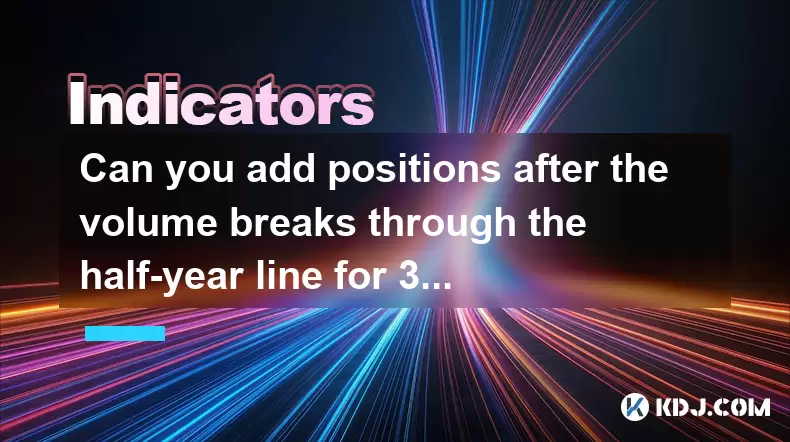
Can you add positions after the volume breaks through the half-year line for 3 consecutive days with reduced volume?
Jun 25,2025 at 08:00pm
Understanding the Half-Year Volume Line in Cryptocurrency TradingIn cryptocurrency trading, technical indicators often guide traders in making decisions. One such metric is the half-year volume line, which refers to the average daily trading volume over a 180-day period. When traders refer to a volume breakout above this line, they are observing whether...
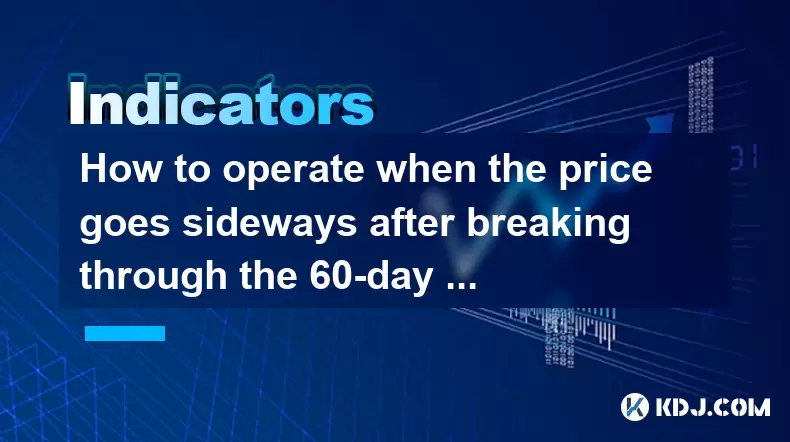
How to operate when the price goes sideways after breaking through the 60-day line with large volume?
Jun 25,2025 at 07:08pm
Understanding the 60-Day Line Breakout with High VolumeWhen a cryptocurrency asset breaks through its 60-day moving average line with large volume, it often signals a potential shift in momentum. This kind of breakout typically suggests that institutional or large retail traders are entering the market aggressively. However, when the price starts to mov...
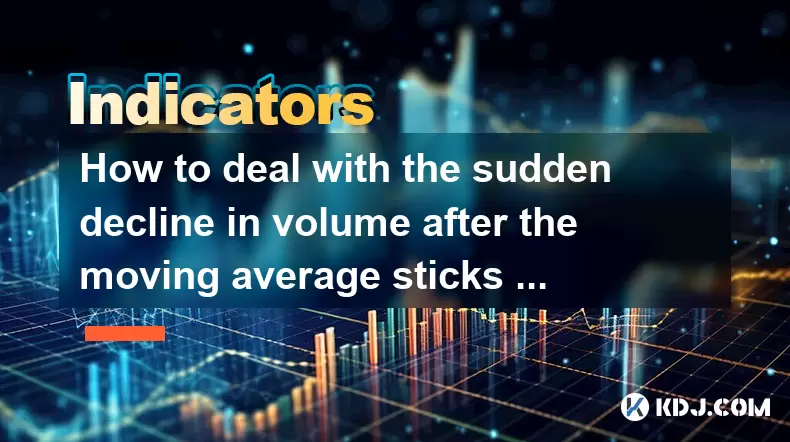
How to deal with the sudden decline in volume after the moving average sticks together?
Jun 25,2025 at 06:35pm
Understanding the Moving Average Convergence and Its ImplicationsIn the world of cryptocurrency trading, moving averages (MAs) are essential tools used to identify trends and potential reversals. When multiple moving averages converge or 'stick together,' it often indicates a period of consolidation or indecision in the market. This phenomenon can be ob...
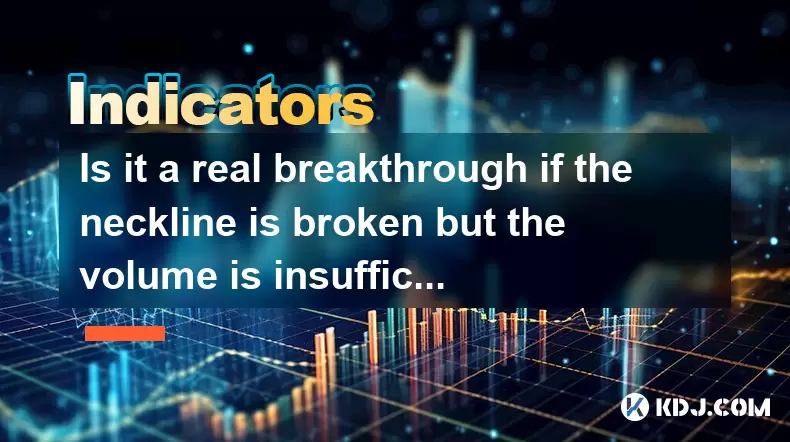
Is it a real breakthrough if the neckline is broken but the volume is insufficient?
Jun 25,2025 at 07:49pm
Understanding the Neckline in Technical AnalysisIn cryptocurrency trading, technical analysis plays a pivotal role in identifying potential price movements. One of the most significant patterns traders monitor is the head and shoulders pattern, which often signals a reversal from an uptrend to a downtrend. The neckline serves as a critical support or re...
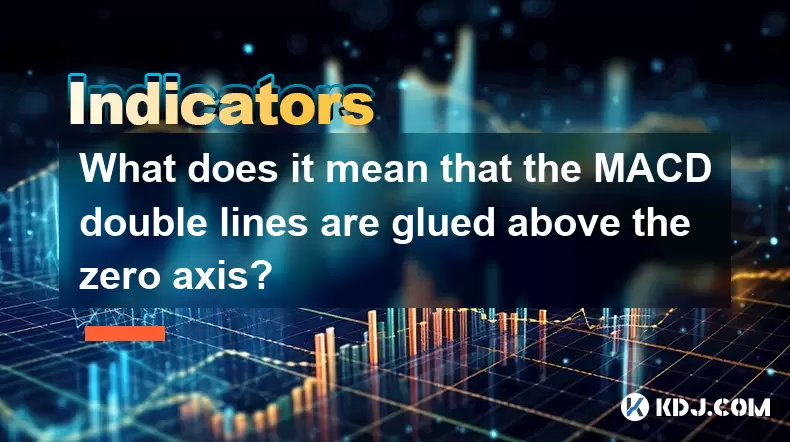
What does it mean that the MACD double lines are glued above the zero axis?
Jun 25,2025 at 07:22pm
Understanding the MACD Indicator in Cryptocurrency TradingThe Moving Average Convergence Divergence (MACD) is one of the most widely used technical indicators among cryptocurrency traders. It helps identify potential trend reversals, momentum shifts, and entry or exit points. The MACD consists of three main components: the MACD line, the signal line, an...
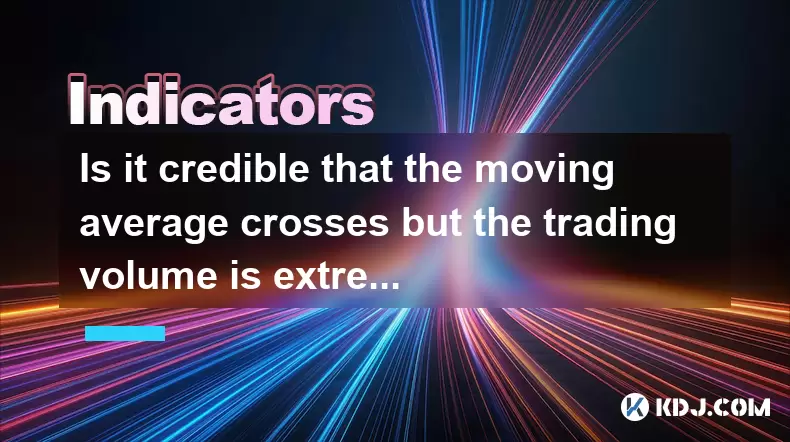
Is it credible that the moving average crosses but the trading volume is extremely shrinking?
Jun 25,2025 at 07:28pm
Understanding the Moving Average CrossoverA moving average crossover is one of the most widely used technical indicators in cryptocurrency trading. It typically involves two moving averages — a short-term (e.g., 9-day) and a long-term (e.g., 21-day). When the short-term crosses above the long-term, it's considered a bullish signal, while a cross below i...

Can you add positions after the volume breaks through the half-year line for 3 consecutive days with reduced volume?
Jun 25,2025 at 08:00pm
Understanding the Half-Year Volume Line in Cryptocurrency TradingIn cryptocurrency trading, technical indicators often guide traders in making decisions. One such metric is the half-year volume line, which refers to the average daily trading volume over a 180-day period. When traders refer to a volume breakout above this line, they are observing whether...

How to operate when the price goes sideways after breaking through the 60-day line with large volume?
Jun 25,2025 at 07:08pm
Understanding the 60-Day Line Breakout with High VolumeWhen a cryptocurrency asset breaks through its 60-day moving average line with large volume, it often signals a potential shift in momentum. This kind of breakout typically suggests that institutional or large retail traders are entering the market aggressively. However, when the price starts to mov...

How to deal with the sudden decline in volume after the moving average sticks together?
Jun 25,2025 at 06:35pm
Understanding the Moving Average Convergence and Its ImplicationsIn the world of cryptocurrency trading, moving averages (MAs) are essential tools used to identify trends and potential reversals. When multiple moving averages converge or 'stick together,' it often indicates a period of consolidation or indecision in the market. This phenomenon can be ob...

Is it a real breakthrough if the neckline is broken but the volume is insufficient?
Jun 25,2025 at 07:49pm
Understanding the Neckline in Technical AnalysisIn cryptocurrency trading, technical analysis plays a pivotal role in identifying potential price movements. One of the most significant patterns traders monitor is the head and shoulders pattern, which often signals a reversal from an uptrend to a downtrend. The neckline serves as a critical support or re...

What does it mean that the MACD double lines are glued above the zero axis?
Jun 25,2025 at 07:22pm
Understanding the MACD Indicator in Cryptocurrency TradingThe Moving Average Convergence Divergence (MACD) is one of the most widely used technical indicators among cryptocurrency traders. It helps identify potential trend reversals, momentum shifts, and entry or exit points. The MACD consists of three main components: the MACD line, the signal line, an...

Is it credible that the moving average crosses but the trading volume is extremely shrinking?
Jun 25,2025 at 07:28pm
Understanding the Moving Average CrossoverA moving average crossover is one of the most widely used technical indicators in cryptocurrency trading. It typically involves two moving averages — a short-term (e.g., 9-day) and a long-term (e.g., 21-day). When the short-term crosses above the long-term, it's considered a bullish signal, while a cross below i...
See all articles
























































































